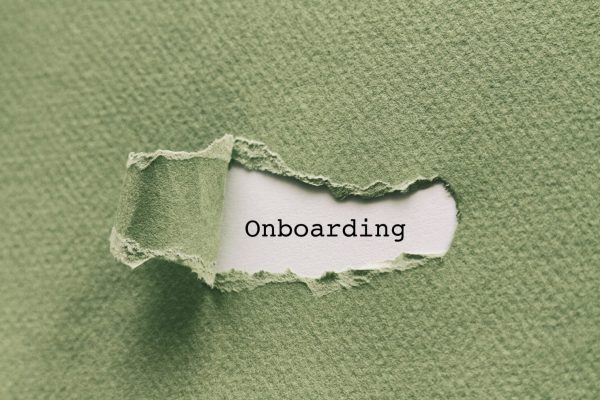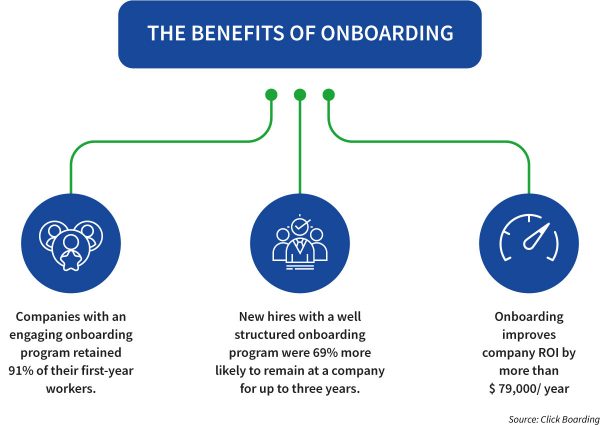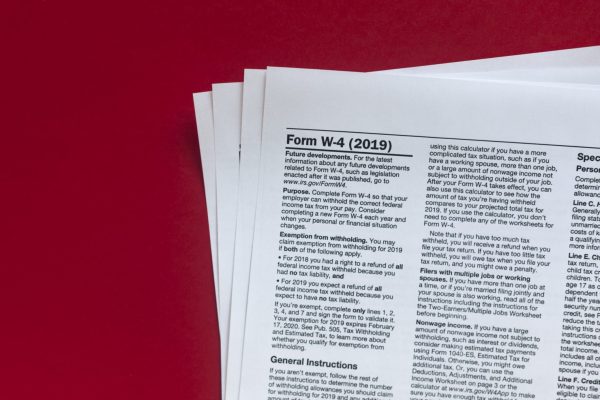The onboarding process is what bridges the gap between the candidate and employee experience. This transitional phase is subtle and quick, but, when given due consideration and care, pays off in dividends in the long run.
Onboarding is one of foundational building blocks of Hiring Success. Unfortunately, all too often it’s a process that’s overlooked and underrated. As a formal introduction, an effective onboarding process can put new employees on the path to success in your company, or steer them in the opposite direction.
In an age when companies are now investing more than ever in the acquisition and retention of talent—why do anything less than guide employees, at every step of the journey, to total success?
Let’s take a closer look at the true value of onboarding, what makes for a memorable onboarding experience, as well as what your company can to do continuously measure, build, and improve upon its process.
What Is Onboarding?
Employee onboarding is the process of formally integrating new employees into your organization, making them feel welcome and immersed in your company’s culture, as well as introducing them to the tools and teams they will be working with.

Onboarding can take many shapes and forms. In some companies, it consists of meetings and presentations in which new hires passively learn policies and procedures. In others, it’s a much more laid back affair and can consist of games, skits, costumes, thumping music, and a limbo bars.
No matter the approach, onboarding’s main objective is to ensure that newcomers feel welcome and comfortable in their new environment, and to provide them with the necessary skills, knowledge, and resources needed to begin their working relationship with your company on a positive, productive note.
Why It Matters
In many ways, the onboarding process isn’t so different from the first day of school—an experience that’s almost universally considered to be anxiety-provoking. It doesn’t have to be, though.
All that’s necessary to bridge the gap between two strangers is a handshake and a hello. Think of onboarding as an extended handshake and hello; an ice breaker to facilitate relationship building between new hires and their colleagues. The sooner they’re comfortable, the sooner they’ll feel at ease, confident, and ready to dive into their work.

Failing to do so, however, could potentially leave employees feeling unintegrated, disengaged, and ultimately disinterested. Furthermore, the absence of a formal onboarding can hinder the productivity of new employees, as well as their colleagues and supervisors.
Don’t take our word for it, though. According to Click Boarding, an HR-tech platform based in Minnesota, there’s some pretty convincing data that highlights the importance of onboarding.

- Companies with an engaging onboarding program retained 91% of their first-year workers.
- New hires with a well structured onboarding program were 69% more likely to remain at a company for up to three years.
- Onboarding improves company ROI by more than $79,000 / year.
The Essentials
1) Don’t Wait for Day One
As the old saying goes, “Why put off until tomorrow what you can start today?” Onboarding is no exception. You don’t have to wait until the actual orientation to start bringing new hires into the fold.

Small gestures like sending a welcome email or hand-written note to your future colleagues— or encouraging your team to reach out on LinkedIn and say “hey”—are highly encouraged during the onboarding process. It requires only minutes of your time and sends a signal of acceptance to newcomers early on that they’re sure to appreciate.
2) Everyone Loves a Good Story
You can’t realistically expect someone who’s going to work for you to become professionally invested in your company without good reason. Sure, you can always make the argument that pay is a good motivator, but transactional agreements can only carry you so far. Plus, times have changed and so have the workplace priorities of employees.
How do you convey the importance of your company to new hires, then? It’s pretty simple, actually. Tell them an honest, good old-fashioned story.
Try to think of a friend or family member who possesses the gift of gab and whose words can enchant and leave you spellbound, wanting to know more. Narrative can be captivating and persuasive—this pertains not just to individual people, but to groups of people (companies), as well.
Think about it for a minute. There’s a good chance you’re at least somewhat familiar with the life story of someone like Bill Gates; that he founded Microsoft in a garage in the 70s, within a decade became the youngest billionaire ever at 31, and in addition to being a hugely successful entrepreneur, dedicated himself to a life of philanthropy. His (and Microsoft’s) is a story that’s well-known.

Not every company will have a tale to tell that’s on par with Microsoft’s, but a backstory of that magnitude isn’t even necessary. If you can honestly explain the “who,” the “what,” and the “why” of your company, that will already make it more relatable than an impersonal business whose intentions and character are left to speculation.
Someone in your company surely already has a great elevator pitch for investors. Put one together for the people who will be investing their time and effort into the success of your company.
3) Provide Some Purpose
To long for a purpose in life is to be human. Therefore, considering the fact that as adults we spend the bulk of our waking hours at work, it stands to reason that people also long for purpose in their careers.
Keep this in mind when designing your onboarding process. What purpose is your company trying to achieve? Do you have goals and projects in place to make that purpose a reality? That’s not to say that your company’s purpose should mirror that of a non-profit’s if, for example, it’s an accounting firm. The exact definition of purpose is flexible. What’s important is that you clearly communicate that purpose during onboarding, and thereafter.

Even if it’s a simple, straightforward purpose with supporting goals and objectives, it will help your workforce to rationally understand the “how” and “why” behind their work. Additionally, people tend to be more cooperative when they’re given a purpose/reason for their actions.
4) Teamwork Makes the Dream Work
Your organization’s main assets are the people that make it run. As people are social animals, it’s important to emphasize values like cooperation and trust. Cultivate an appreciation for these values from day one by embedding related activities into your onboarding. The development and maintenance of interpersonal relationships at work is an ongoing task; impress the importance of said relationships from the start.
5) Play the Part of Cultural Informant
Make sure your new hires know the layout of the office and the social aspects that come with it. For example if people in the company often go out for coffee in the afternoon, make that known. If competitive games of foosball are a regular occurrence, but only after lunch, let them know. Insider tips like these help employees come into the fold with confidence.
6) Formidable Forms and Formalities
While there are several cool and unconventional ways to make the onboarding experience really enjoyable—unfortunately there are others that will probably never cease to be a bit dull. Like filling out state and federal tax withholding forms. However, it’s a very important part of the process. One that requires attention to detail, for the sake of your company and the employees you’re onboarding.

Make sure that you inform yourself and new employees of what paperwork will have to be completed before their first day. It’s also important to set aside time to thoroughly explain labor laws, safety regulations, company-related compliance requirements, as well as those mandated by local, state, and international governing bodies. For example, General Data Protection Regulations (GDPR) regulations or the California Consumer Privacy Act (CCPA)
7) Be Visual and Straightforward
New jobs can be daunting. Sometimes it can take new hires months to settle in, understand all the working parts, and realize how they fit in to the big picture. There’s a lot of information to take in at first.

Therefore, if you can find a way to clearly and visually explain (cue up your org charts!) the structure of your company, hierarchy of management, the general division of labor among departments, and how all of that ties back to the responsibilities and workflows of new hires, it will definitely make the whole experience slightly more digestible.
Need some inspiration on how to create a great org chart? Check out the following resource from Microsoft.
8) Be Resourceful and Friendly
Set your employees up for success by letting them know where to turn if they need something. Remember, it can take awhile to get set up during the first few weeks (or longer) at the office. Newcomers need time to get into the groove, establish a routine, internalize new processes, and so on.

Inevitably, they’ll have a lot of questions and gaps in their knowledge. This doesn’t come without at least a touch of anxiety for most people. You can help mitigate that by having go-to resources and knowledge repositories for everything related to your company’s processes, guidelines, resources, and regulations. That could be something as simple as a shared folder in Google Drive or a thorough Confluence Page. Knowledge is power. Share it.
Make Your Checklists and Check Them Twice ☑️ ☑️
Depending on how involved your company’s onboarding process is, you—and new hires you onboard—might have to take care of several administrative tasks like filling out forms. If you happen to be onboarding a large cohort, the number of tasks you’ll be faced with could start to multiply like quickly. To stay on top of the tasks at hand, lean on one of the organizational tools around—the list.
It’s not the list in and of itself that’s important. Rather, it’s what it represents and helps accomplish—organization and standardization. Both essential to onboarding. If you misplace or outright forget to collect an importance document from a new hire, like their payroll information of work permit, the consequences could be very inconvenient.

Or imagine the following scenario: a group of employees is onboarded and informed of a newly implemented company perk like a yearly personal development budget for everyone in the company. However, two weeks later the next group of new hires don’t receive that info during their onboarding process, only to find out weeks or months after the fact.
Might seem like a small oversight, and it’s one that could easily happen depending on how many people in your company are responsible for onboarding, but it won’t be viewed that way by your colleagues if they’re under the impression that there’s a lack of parity in the company when it comes to benefits.
Best way to avoid such snafus? You guessed it: checklists. Below you’ll find four free and thorough onboarding checklist templates available for download.
Keep Count of Costs to Make the Most of Your Process
In order to maximize the money you invest in onboarding, it’s important to first determine the associated costs, such as the following examples:
Onboarding Paperwork and Administrative Time
- Let’s say you have an HR assistant that you pay $15.00 an hour, If you hire 70 new employees per year and it takes an average of 10 hours of admin time, per new hire, to process their paperwork— that adds up to $10,500 per year.
Cost of Management to Onboard and Train New Hires
- If you’re Head of People (who makes $80,000 per year) spends 8 hours on onboarding per new hire, and you hire 70 new people per year—that amounts to $21,280 per year.

Taking just these two costs into account, for a company that hires 70 new employees per year, the average costs amounts to $454 per new hire. However, there are a handful of other factors that should be taken into consideration, too:
- How much time do team members in other departments (such as IT) spend, on average, helping with onboarding and training?
- How much money, per new hire, is spent on the welcome kit / package?
- What’s the average cost per new hire for hardware, software, furniture, and other supplies?
Stretching Your Onboarding Bucks
When you have a more granular view of the money required for onboarding, you can then begin to explore products and solutions that could potentially save you valuable time and money. For example, if you know that you spent approximately $10,500 per year on administrative paperwork and you find a company that guarantees they can reduce that cost by half through digital document delivery—that’s an option worth pursuing.
Another way optimize the money you allocate to onboarding is to leverage the synergies of your recruitment and learning & development (L&D) budgets.
According to organizational psychologist and leadership coach Alison JY Lee: “Valuable information about each new hire is collected through the hours spent in the recruiting process. By the time of onboarding, you should have information on their key strengths and the key challenges that may affect their engagement and performance in the company. Using that information, you could sync with L&D to address these areas with an individualized development plan from the get-go. This way, you’ll be able to extend value from recruitment spending into performance, and get savings from the accelerated pace at which a new hire can add value to the business.”
There’s an Integration for That
Like every tool, you need to figure out how to make your applicant tracking system (ATS) work for you. Not the other way around. Fortunately, there are some really great products on the market to make the onboarding process more seamless—and many of them can easily be linked to your ATS.
These integrations will allow you to facilitate many of the administrative aspects of the onboarding process, freeing up your time to focus on the larger task at hand—making it a memorable experience.
Below you’ll find three examples of employee onboarding solutions that just might make your life a little easier.
1) One Less Task to Background Check off the List
Once you’ve extended a candidate an offer, chances are you might need to run a routine background check before proceeding to the next step. Often these are seen in food service and retail, but they are also commonplace in high security clearance jobs.
Background check solutions like Checkr make it easy to quickly screen candidates, share the results with your team, and store said results in a centralized location. This cuts down on turnaround time, improves the candidate experience, reduces recruiter workflows, mitigates risk, and helps TA teams maintain compliance.
2) Signed, Sealed, Delivered!
There was a time when one of the greatest occupational hazards that HR teams faced was paper cuts—especially when onboarding new hires. Fortunately, that’s no longer the case.

Thanks to companies like DocuSign, it’s now possible to electronically create, send, and receive legally binding signatures for important documents like offer letters and job contracts. Just think of all the time (and paper cuts) you’ll save by not having to fill out forms, take trips to the post office, or schedule meetings for the sole purpose of signing documents.
3) Welcome Talent as You Would Like to be Welcomed
Did you know that 22% of new hires leave the job within the first 45 days? If only they’d had a more memorable onboarding experience!
Platforms such as ClickBoarding have made the entire onboarding process accessible, easy, and an obvious choice for any company looking to add a bit of pizazz to the way they welcome new talent.
To borrow their messaging: “Keep new hires connected and engaged with the brand they fell in love with. Welcome them with a video, office map, cultural norms, and any other content that tells your story. Add branded content during every part of the experience to start building their loyalty even before day one.”
Top 5 Takeaways to Keep in Mind
Coming Attractions—2021: SmartRecruiters’ Onboarding Solution
The onboarding process, among other things, bridges the transition between the candidate journey and employment. When executed well, it helps facilitate an experience for the job seeker / soon-to-be employee that’s seamless and memorable.
If mishandled, it creates for a dissonant experience. One that might make a new hire question their decision to accept the job your company has offered them.
Needless to say, there’s a lot at stake. Therefore, SmartRecruiters is pleased to announce that we will be offering onboarding functionality as a native, integrated feature on our talent acquisition suite as of 2021. More details can be found in the above keynote presentation from SmartRecruiters’ Head of Product, Natalia Baryshnikova’s, at this year’s Hiring Success conference.
Now that you’ve got a handle on how to take your onboarding game to the next level, what’s next? Make every phase of your candidate experience memorable. We’ll show you how in The Definitive Guide to Hiring Success.











